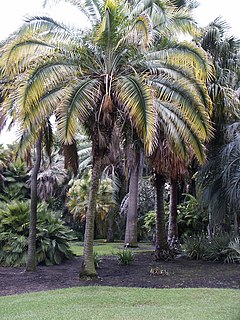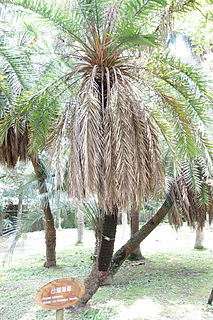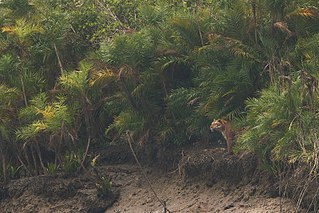
The Andaman Islands is an archipelago in the northeastern Indian Ocean about 130 km (81 mi) southwest off the coasts of Myanmar's Ayeyarwady Region. Together with the Nicobar Islands to their south, the Andamans serve as a maritime boundary between the Bay of Bengal to the west and the Andaman Sea to the east. Most of the islands are part of the Andaman and Nicobar Islands, a Union Territory of India, while the Coco Islands and Preparis Island in the archipelago's north belong to Myanmar.

Phoenix is a genus of 14 species of palms, native to an area starting from the Canary Islands in the west, across northern and central Africa, to the extreme southeast of Europe (Crete), and continuing throughout southern Asia from Turkey east to southern China and Malaysia. The diverse habitats they occupy include swamps, deserts, and mangrove sea coasts. Most Phoenix species originate in semiarid regions, but usually occur near high groundwater levels, rivers, or springs. The genus is unusual among members of subfamily Coryphoideae in having pinnate, rather than palmate leaves; tribe Caryoteae also have pinnate or bipinnate leaves.
The Andaman worm snake is a species of harmless blind snake in the family Gerrhopilidae. The species is endemic to the Andaman Islands. No subspecies are currently recognized.

Mount Harriet National Park is a national park located in the Andaman and Nicobar Islands union territory of India. The park, established in 1969, covers about 4.62 km2 (18.00 mi2). Mount Harriet, which is part of the park, is the third-highest peak in the Andaman and Nicobar archipelago next to Saddle Peak in North Andaman and Mount Thullier in Great Nicobar.

Bentinckia nicobarica is a species of flowering plant in the family Arecaceae found to occur in the Nicobar group of islands in the Bay of Bengal. It is an endemic palm occurring in Great Nicobar, Katchal, Nancowry and Car Nicobar Islands.

Phoenix rupicola or cliff date palm is a species of flowering plant in the palm family, native to the mountainous forests of India and Bhutan from 300 to 1200 m, usually occurring on cliffs, hillsides and similar terrain. It is threatened by habitat loss in its native range. On the other hand, the species is reportedly naturalised in the Andaman Islands, the Leeward Islands, Cuba and Puerto Rico and a specimen has recently been reported in Saint Lucia.
Ingerana charlesdarwini is a species of frogs in the family Dicroglossidae. It is endemic to the Andaman Islands, India, and is known from the South Andaman Island, Long Island, and North Andaman Island.

Phoenix acaulis the dwarf date palm or stemless date palm, is a species of flowering plant in the palm family, native to northern India, Bhutan and Nepal. Found in altitudes from 350 to 1500 m, Phoenix acaulis grows in scrubland, savannas and in pine forests. Trunks in this species remain underground or, at most, grow to a few inches in height. Leaves are 1.5 m long, gray-green, with 25 cm, pinnately arranged leaflets on short, armed petioles.
Phoenix caespitosa is a species of flowering plant in the palm family native to the Arabian Peninsula and the deserts of Somalia. This species grows in large clumps near oases or underground springs. The trunks are short, often subterranean, in readily clumping clusters with 3 m leaves divided into 15 to 45 cm, bluish-green leaflets.

Phoenix loureiroi is a species of flowering plant in the palm family, indigenous to southern Asia, from the Philippines, Taiwan, India, southern Bhutan, Burma, Thailand, Cambodia, Vietnam, Pakistan, and China. It occurs in deciduous and evergreen forests and in clear terrain from sea level to 1,500 m altitude.

Phoenix paludosa, also called the mangrove date palm, is a species of flowering plant in the palm family, indigenous to coastal regions of India, Bangladesh, Myanmar, Thailand, Cambodia, Sumatra, Vietnam and peninsular Malaysia. They are also known as Sea Dates. The trees grow in clusters, to 5 m high, usually forming dense thickets. The leaves are 2 to 3 m long and recurved.

Phoenix sylvestris also known as silver date palm, Indian date, sugar date palm or wild date palm, is a species of flowering plant in the palm family native to southern Pakistan, most of India, Sri Lanka, Nepal, Bhutan, Myanmar and Bangladesh. It is also reportedly naturalized in Mauritius, the Chagos Archipelago, Puerto Rico and the Leeward Islands. Growing in plains and scrubland up to 1300 m above sea level, the fruit from this palm species is used to make wine and jelly. The sap is tapped and drunk fresh or fermented into toddy. The fresh sap is boiled to make palm jaggery in West Bengal state of India and Bangladesh.

Dictyosperma is a monotypic genus of flowering plant in the palm family found in the Mascarene Islands in the Indian Ocean. The sole species, Dictyosperma album, is widely cultivated in the tropics but has been farmed to near extinction in its native habitat. It is commonly called princess palm or hurricane palm, the latter owing to its ability to withstand strong winds by easily shedding leaves. It is closely related to, and resembles, palms in the genus Archontophoenix. The genus is named from two Greek words meaning "net" and "seed" and the epithet is Latin for "white", the common color of the crownshaft at the top of the trunk.

Pinanga andamanensis is one of the critically endangered species of endemic palms reported from the Andaman Islands.
Korthalsia rogersii is an endangered endemic rattan species, thought to be extinct from the insular habitat of the Andaman Islands in the Indian Ocean until 1993. Korthalsia rogersii was first described by Odoardo Beccari in 1918 based on two herbarium field specimens collected by C. G. Rogers in 1904 from the South Andaman Island. This species was known only from these two collections until 1993. Sam Mathew and Pakshirajan Lakshminarasinhan were able to find the species again at Chidiyatapu forests of the South Andamans after a gap of about 100 years. Live collections are introduced at Tropical Botanical Garden and Research Institute, Trivandrum, South India.

The Andaman Canopy Agama is an agamid lizard endemic to the Andaman Islands. It is also known as the Andaman Green Calotes. This species is an almost exclusive canopy dweller, and is rarely seen.

Mimusops andamanensis is a species of plant in the family Sapotaceae. It is native to Sri Lanka and the Andaman Islands.
Piper ribesioides, also known as Lao chili wood, mai sakhaan, sankhaan, sankharn, sankahn or sakahn is a species of black pepper plant. The woody vine or stem of the plant has a hot, peppery and chili flavour, with a lingering aftertaste and slightly numbing sensation to the tongue. It is commonly used in Lao cuisine both in Laos and the predominately Lao ethnic region of Northeastern Thailand. It is the most important ingredient in Laos' famous Or lam. Its berries are sometimes pressed for an oil that is also used in cooking.
Cryptocarya caesia is a tree in the family Lauraceae reported from Java Island in Indonesia and the Andaman Islands in the Bay of Bengal. This species was originally described by Blume from Java in 1851. Later, in 1884, George King located this tree in Port Blair in the Andaman Islands and collected some herbarium specimens.
Rotala andamanensis is a lesser-known endemic wetland plant species of the Andaman Islands in the Bay of Bengal belonging to the family Lythraceae. The type locality of this species is Wright Myo, the southern slope of the Mount Harriet Hill ranges. This is a rather rare species found to occur along the wetland area of the region. The specimens were originally collected by Balakrishnan of the Botanical Survey of India and described by Sam Mathew and Lakshminarashimhan of the same institution in 1992.
1. Barrow, Sasha C. 1998. Kew Bulletin 53: 538,
2. Mathew, S. P. 2016: Natural History of Phoenix andamanensis from the Andaman islands. Palms 60: 194-200













